OAHN Poultry Expert Network Quarterly Producer Report
Leveraging Artificial Intelligence-Based Decision Support Tools for the Control of Avian Influenza Outbreaks
Rozita Dara, Professor of Computer Science and co-Director of AI4Food, University of Guelph
In recent years, avian influenza outbreaks have become more frequent and severe, posing serious threats to poultry farms and public health. Emergency responders are at the forefront of managing these threats, making decisions crucial to prevent economic losses and protect people from zoonotic infections. To do this effectively, advanced tools that support decision-making are increasingly needed. Integrating artificial intelligence (AI) into these tools offers new possibilities for better surveillance, outbreak prediction, and evaluation of control measures.
Controlling avian influenza requires proactive, evidence-based strategies. Early detection of outbreaks allows for timely actions such as culling infected birds, improving biosecurity, deploying vaccines, and restricting movement. However, traditional manual surveillance methods often face delays and may not provide complete information, which can hinder rapid responses. There’s a clear need for intelligent systems that can analyze large amounts of data, recognize patterns, and predict where outbreaks might occur. These tools can incorporate various data sources, including climate patterns, migratory routes, farm details, land cover, and social media signals, to provide real-time risk assessments. This helps authorities prioritize resources, target interventions, and communicate risks effectively.
Decision Support Systems (DSS) are computer platforms designed to assist officials and field teams in making well-informed choices. They gather data from multiple sources, clean and organize it, and apply simple or advanced AI techniques to analyze information. In the context of avian influenza control, DSS act as centralized hubs that collect, analyze, and visualize data, run scenario models, and suggest the best actions based on current evidence. Some advanced systems even use digital twin technology, virtual models of farms or regions, to simulate “what-if” scenarios and test different strategies.
For example, a DSS might use GIS mapping to show where infections are clustered, predict how the virus could spread along migratory pathways, and assess what impact different interventions might have. By providing a comprehensive overview of possible futures, these tools enhance situational awareness, ensuring decision-makers act based on solid data rather than assumptions. This approach not only improves response efficiency but also helps optimize resource use.
The effectiveness of decision support tools depends heavily on data sharing and collaboration. International and regional platforms for data exchange enable outbreak reports, genetic information, farm data, and environmental data to be pooled. Sharing information quickly accelerates the detection of emerging threats and supports coordinated responses across borders. Benchmarking—comparing performance across regions and farms—helps identify best practices and points for improvement, promoting continuous learning and refinement of control strategies.
Implementing these decision support tools successfully requires robust digital infrastructure, investment in technology, capacity building, and stakeholder engagement. Governments, research organizations, and industry players must collaborate to develop the necessary legal, ethical, technical, and organizational frameworks. Transparency and data privacy are critical considerations to maintain trust and encourage participation widely.
In summary, avian influenza remains a significant global threat, but leveraging AI-powered decision support tools can greatly improve how we prevent and manage outbreaks. Through collaboration and investment in advanced technologies, the public health and poultry sector can better predict, track, and control avian influenza, safeguarding both poultry health and public safety.
Newcastle disease
Newcastle disease (ND): on June 4, 2025, the NCFAD confirmed the presence of ND on two pigeon commercial farms raised for meat production in the Fraser Valley. This is the first confirmed case of ND in a Canadian poultry operation since 1973.
ND is a reportable disease under the Health of Animals Act and is notifiable to WOAH should it be confirmed in poultry. Industry notice – The Canadian Food Inspection Agency detects Newcastle disease in BC pigeons – inspection.canada.ca
Poultry Veterinarian Survey Highlights – Q2 2025 (Mar-May 2025)
Broilers
Most of the conditions were seen stable to slightly increased this quarter.
Practitioners
Stable conditions: ILT, lameness developmental, histomoniasis, avian influenza and avian metapneumovirus (aMPV) infections with associated comorbidities: E. coli, IBV and IBD infections but also increased condemnation rate.
Stable to increased conditions: early systemic bacterial infection (E. coli and E. cecorum), late systemic bacterial infection (E. coli and E. cecorum), infectious bronchitis (IBV), condemnation issue (cellulitis and chronic respiratory disease) , infectious bursal disease (IBVD) , lameness of bacterial origin (E. coli and E. cecorum), lameness of viral origin (reovirus) and necrotic enteritis.
Stable to decreased conditions: runting stunting syndrome (RSS), salmonellosis, chicken anemia virus (CAV), other causes of mortality (dehydration and starve out), lameness nutritional, ascites and spiking mortality.
Increased to equal stable or decreased conditions: coccidiosis and inclusion body hepatitis.
aMPV- lack of clinical signs but serology positive detection and increase in condemnation rate suspected to be attributed to aMPV infections. IBD, IBV and E. coli were the most encountered comorbidities detected in affected flocks.
Below graph depicts the frequency of the conditions seen in the flocks. The most frequent 3 conditions seen this quarter were:
Early systemic bacterial infection (<14 d old)
Lameness (Bacterial)
Inclusion body hepatitis (IBH) and Condemnation issues

AHL
Similar number of cases (from previous quarter):
Early systemic bacterial infection (< 14 days old) – All cases of septicemia had E. coli isolated. A yolk sac infection had E. cecorum and E. coli isolated.
Lameness developmental (tibial dyschondroplasia).
RSS – Confirmed.
ILT (2 PCR).
Increased number of cases (from previous quarter):
Lameness bacterial (Primarily diagnosed on histology) – E. coli or E. cecorum isolated either in pure culture or in combination. A case of osteomyelitis had E. coli and E. cecorum isolated.
RSS – Suspect.
Decreased number of cases (from previous quarter):
Other causes of early mortality (< 14 days old) – Dehydration.
Late systemic bacterial infection (> 14 days old) – E. coli isolated either in pure culture or in combination with E. cecorum.
Lameness nutritional (rickets).
Lameness viral (Reovirus confirmed: SK_R12, BC-17-0408-2017, ON_variant_A_12-073195, ON_variant_E_12-090746 and Pennsylvania 13-095523.)
Lameness viral (Reovirus suspicious, primarily diagnosed on histology).
Coccidiosis (small intestine).
Inclusion body hepatitis (FAdVE, FAdVD, FAdVE/FAdVAC, FAdVD/FAdVAC, FAdVE/FAdVD/FAdVAC, FAdV08b_AHL_16-049095_ON, FAdV08b_AHL_18-057921_ON and FAdV11_USA_1047).
Infectious bronchitis (IBV – pathology cases and PCR positive)( Field strains: IBV_DMV_ON_21-017385 and IBV_USA_G08. Vaccine strains: IBV_Conn and IBV_Mass-MA5 vaccine.)
Infectious bursal disease (PCR positive field strains: USA PA105-2014, British Columbia 15-062782 and USA Del-E. Vaccine strains: UK Faragher52-70 and USA W2512-Blen).
No cases diagnosed this quarter:
Necrotic enteritis.
Avian metapneumovirus (Type B).
Spiking mortality.
Dead on arrival (DOA).
Other diagnostic findings:
Proventriculitis, ventriculitis, conjunctivitis, airsacculitis, pneumonia, heterophilic typhlitis with adherent bacteria and myodegeneration.
Salmonella:
Animal Health Laboratory Salmonella Isolations: Broilers (blue dashed lines indicate quarter periods: Dec-Feb, Mar-May, Jun-Aug, Sept-Nov).

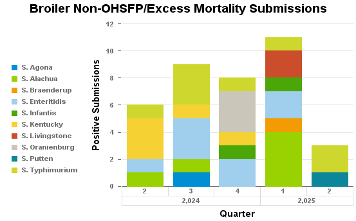
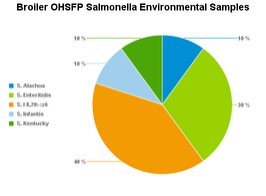
Condemnation conditions in provincial slaughter plants reported for period of March- May 2025. Top 3 main conditions listed for this quarter were: ascites, contamination and airsacculitis.

Chickens processed in provincial plants and condemnation percentage (March-May 2025)
| March | April | May | |
| Chicken slaughtered | 1,806,607 | 1,808,418 | 1,755,911 |
| Chicken condemned | 41,799 | 41,918 | 44,345 |
| Percentage | 2.31 | 2.32 | 2.53 |
Number of chickens slaughtered by province, Jan-Dec 2024 and January-February 2025 (CAHSS Federally Inspected Slaughter Data).
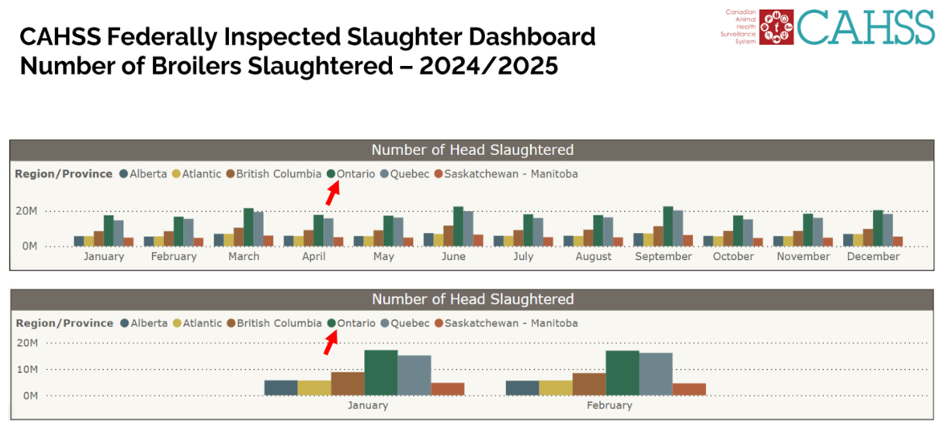 Top 10 chicken postmortem condemnation conditions per 10,000 slaughtered by province, Jan-Dec 2024 (CAHSS Federally Inspected Slaughter Data).
Top 10 chicken postmortem condemnation conditions per 10,000 slaughtered by province, Jan-Dec 2024 (CAHSS Federally Inspected Slaughter Data).
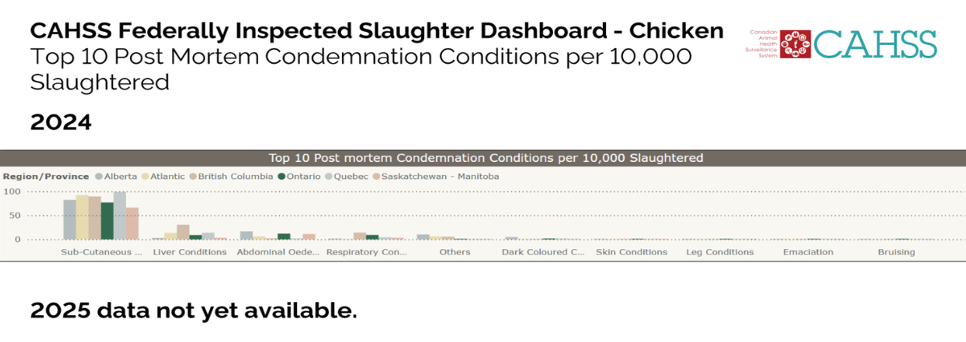
Subcutaneous conditions, abdominal edema, and respiratory conditions were reported as the main conditions for condemnation for chickens slaughtered in federally inspected plants in Ontario in 2024 (dark green bars).
Broiler-Breeders
Most of the conditions were reported stable this quarter with an increase in bacterial lameness, late systemic bacterial infections and IBH cases. Practitioners reported an increase in heat stress related conditions such as production challenges and increase percentage of mortality especially in flocks raised in traditional build barns that are not equipped with tunnel like ventilation system.
Practitioners
Stable conditions: lameness developmental/viral/nutritional, IBV-sudden spike in mortality, necrotic enteritis, fowl pox, ILT, salmonellosis, disease related to hatchability issue, multi-drug-resistant E. coli (resistant to >3 drugs), avian influenza and pre-lay morbidity/mortality.
Stable to slightly increased conditions: bacterial lameness (S. aureus, E. cecorum and E. coli), coccidiosis, Salmonella isolation (S. Thyphimurium), histomoniasis (possibly incidental finding in an individual bird and not on the entire flock) and aMPV.
Stable to decreased conditions: fowl cholera, early bacterial infection (E. coli, S. aureus and E. cecorum), CAV, other causes of mortality, in-lay bacterial septicemia (E. coli), aggression and cannibalism.
Stable with equally increased or decreased conditions: IBV decreased production/egg abnormality and Mycoplasma synoviae.
Observations on aMPV infection: neurological signs (mild signs on the entire flock but severe in individual affected birds), snicking, swollen heads, bronchitis, bacterial septicemia and increased rate of culling. After disease runs its course, infected birds are blind and this condition is associated with lack of menace reflex, mild uveitis or panuveitis and evidence of long-lasting secondary infections.
Below graph depicts the frequency of the conditions seen in the flocks. The most frequent 3 conditions seen this quarter were:
Lameness- bacterial
In-Lay bacterial septicemia
Early bacterial infection (<14 d old)
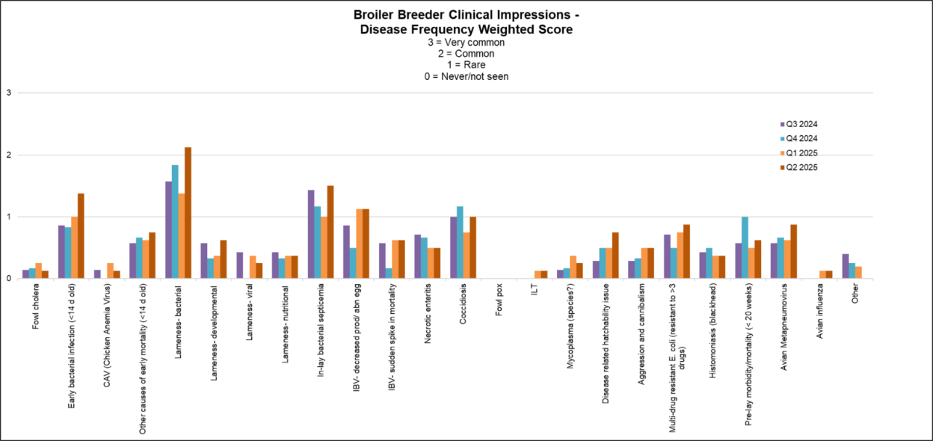
AHL
Fowl cholera (Pasteurella multocida) – Occasionally isolated from lameness cases from vaccinated flocks.
Similar number of cases (from previous quarter):
Inlay bacterial septicemia – E. coli and S. aureus were isolated in pure culture and in combination. S. aureus was also isolated with S. hyicus or G. anatis and C. perfringens. E. coli and E. cecorum were isolated together as well as in combination with S. aureus, G. anatis, or S. aureus and C. perfringens. Trueperella pyogenes was also isolated in pure culture.
Trauma (tendon rupture).
Other causes of inlay mortality – Cannibalism.
Urate nephrosis/visceral urates/articular urates.
Amyloidosis.
Increased number of cases (from previous quarter):
Cellulitis/Dermatitis – E. coli, S. aureus and E. cecorum are isolated together in 1 case. E. cecorum was isolated from a case of inguinal cellulitis.
Bacterial pneumonia – E. coli isolated alone or in combination with S. aureus.
Avian metapneumovirus (Type B) – Coinfections include meningoencephalomyelitis, osteomyelitis and otitis media.
Pododermatitis – E. coli and S. aureus isolated together as well as in combination with E. coli.
Coccidiosis – Identified in the small intestines (E. necatrix), ceca or both.
Intestinal parasitism – Histomonas and nematodes.
Mycoplasmosis (MS).
Decreased number of cases (from previous quarter):
Early bacterial infection (<14 days old) – Cases of septicemia had E. coli isolated in pure culture and with S. aureus. E. coli and E. cecorum were isolated together as well as in combination with P. aeruginosa. Cases of yolk sacculitis had E. coli isolated in pure culture or in combination with S. aureus.
Other causes of mortality (> 14 days old) – Dehydration.
Prelay morbidity/mortality (<20 weeks) – S. aureus was isolated in pure culture. E. coli and E. cecorum isolated in combination. Another diagnosis included intussusception.
Lameness bacterial – S. aureus and E. coli were each isolated in pure culture, together and in combination with E. cecorum or Avibacterium spp. Avibacterium spp. was also isolated in pure culture. E. coli and E. cecorum were also isolated in combination. A case of osteomyelitis had S. aureus isolated.
Necrotic enteritis (C. perfringens isolated).
IBV (decreased productivity/abnormal eggs/sudden spike in mortality) – (IBV_DMV_ON_21-017385, IBV_DMV_ON_15-077145, IBV_CA_1734_04_ON_12-025379 and IBV_Mass-MA5 vaccine).
No cases diagnosed this quarter:
Lameness developmental (tibial dyschondroplasia).
Lameness nutritional (rickets).
Lameness viral – Reovirus.
White Chick Syndrome.
Fowl pox.
Other diagnostic findings:
Gangrenous dermatitis (Clostridium sp., C. septicum / E. coli / Clostridium sp., S. aureus / E. coli / C. perfringens, S. aureus / E. cecorum / C. perfringens, S. aureus / E. coli / E. cecorum / C. perfringens, S. aureus / E. coli / E. cecorum), anterior uveitis, salpingitis (E. coli), multisystemic mineralization, necrotizing typhlitis, and fibrinoheterophilic myositis.
Salmonellosis (clinical)/Salmonella isolation
Animal Health Laboratory Salmonella Isolations in Broiler Breeders (see Graph 1 below summarizing isolations by quarter periods Dec-Feb, Mar-May, Jun-Aug, Sept-Nov):
6 positive submissions outside of OHSFP environmental testing (Ontario Hatchery and Supply Flock Program) with 3 S. Typhimurium, 1 S. I 4,5,12:i:- , 1 S. Liverpool and 1 S. Kentucky isolated (Graph 2).
OHSFP environmental samples – S. I 8:20 :-: Z6, S. Kentucky, and S. Livingstone variant 14+ most isolated (Graph 3 showing Apr-Jun 2025 isolations only).
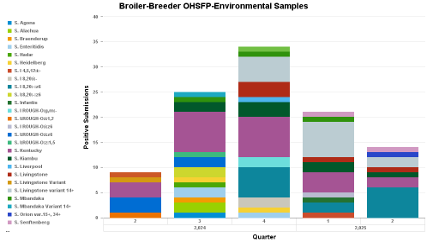
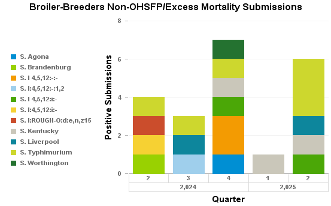
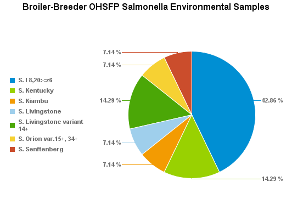
Layers
Veterinarians are reporting good, stable and solid health status in layer flocks. There were more detections of aMPV serotype B with high titers on serology testing this quarter.
Practitioners
Stable conditions: bacterial peritonitis/salpingitis (E. coli), early systemic bacterial infection, other causes of mortality, focal duodenal necrosis (FDN), IBV-production/abnormal egg, IBV- respiratory issues, salmonellosis, ILT, mycoplasmosis, hysteria, aggression and cannibalism, multi-drug-resistant E. coli (resistant to > 3 drugs), histomoniasis and avian influenza.
Stable to slightly increased conditions: osteoporosis, aMPV infections, coccidiosis and necrotic enteritis.
aMPV infections were correlated to several comorbidities such as E. coli and IBV. It was also noted that different breeds were exhibiting different clinical signs: for example, White breeds with slow to peak or production pause for a couple of weeks but no clinical signs whereas Brown breeds were presenting increase in mortality, disease and comorbidities lingering in the flock for prolonged period. The most affected age was between 24 and 26 weeks after birds were transferred from the pullet stage.
The graph on the following page depicts the frequency of the conditions seen in the flocks. The most frequent 3 conditions seen this quarter were:
Bacterial peritonitis/ salpingitis
Avian Metapneumovirus
Osteoporosis
IBV- prod drop/abnormal eggs
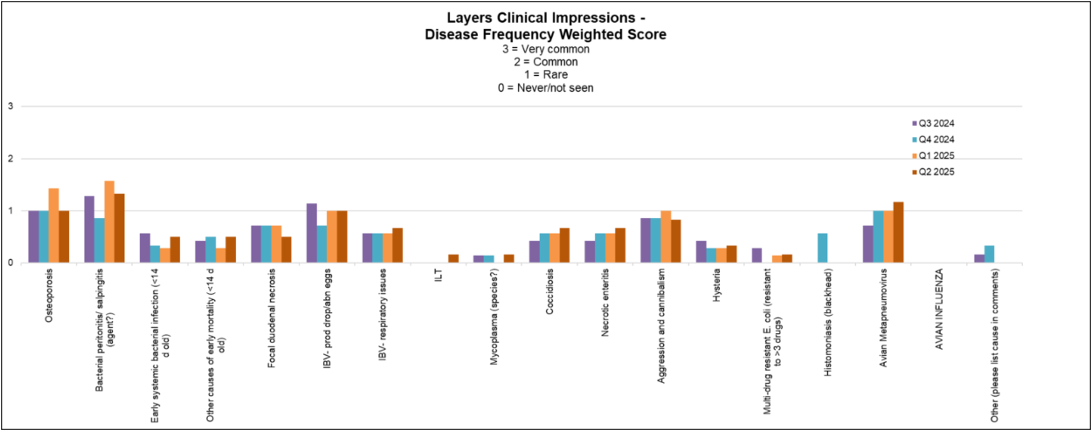
AHL
Similar number of cases (from previous quarter):
In-lay mortality (>20 weeks old) – Septicemia (E. coli, E. cecorum).
Increased number of cases (from previous quarter):
Osteoporosis.
Necrotic enteritis (C. perfringens).
Coccidiosis (Small intestine).
Infectious bronchitis (IBV – production drop/egg abnormalities/ respiratory) – (IBV_DMV_ON_15-077145, IBV_DMV_ON_21-017385, USA_PA-5344-98, IBV_Mass-MA5 vaccine, IBV_USA_Mass_AHL21-008165 vaccine and IBV_Conn vaccine).
Decreased number of cases (from previous quarter):
Early mortality (other) – Hepatic necrosis.
Prelay mortality (<20 weeks old) – Tenosynovitis (E. faecalis).
No cases diagnosed this quarter:
Early mortality (<14 days old, starveouts).
Early mortality (<14 days old, omphalitis).
Leg issues – Trauma, bone fracture.
Leg issues – Bacterial.
Leg issues (other).
Focal duodenal necrosis (FDN).
Intestinal parasitism (other).
Avian metapneumovirus.
Aggression/Hysteria.
ILT.
Mycoplasma.
Elevated DOA.
Other diagnostic findings:
Hepatic fibrosis and FAdV01 USA CELO.
Salmonellosis (clinical)/Salmonella isolation
Animal Health Laboratory Salmonella Isolations in Layers (see graph below summarizing isolations by quarter periods Dec-Feb, Mar-May, Jun-Aug, Sept-Nov):
There were no positive submissions outside of OHSFP environmental testing (Ontario Hatchery and Supply Flock Program) this quarter.
OHSFP environmental samples – S. Kiambu and S. Thompson most isolated (Graph 2 showing Apr-Jun 2025 isolations only).
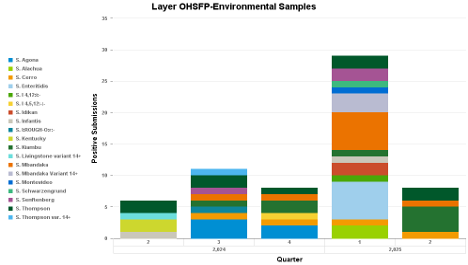
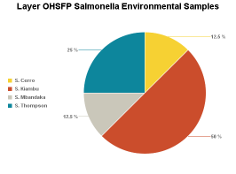
Turkeys
Practitioners
Turkey flocks continue to have health challenges with aMPV type B infection listed as the main condition. Affected flocks are presenting with increase percentage of mortality, and most of the clinical signs are related to secondary E. coli infections.
Stable conditions: fowl cholera, erysipelas, other causes of mortality, mycotic respiratory disease, mycoplasmosis, aggression and cannibalism.
Stable to slightly decreased conditions: necrotic enteritis, enteritis, salmonellosis, reovirus tenosynovitis, round heart, coccidiosis, salmonellosis and histomoniasis.
Stable to slightly increased conditions: late systemic bacterial infection (E. coli), ORT, other respiratory disease, multi drug resistant E. coli (resistant to > 3 drugs) and avian influenza.
Early systemic bacterial infection and aMPV were mainly stable with an equal number of respondents reporting increased and decreased cases this quarter.
aMPV on affected flocks (meat type) was described as 10-30% egg production drop, swollen heads and sinuses, respiratory challenges, air sacculitis, neurological issues, secondary systemic bacterial infections (Mycoplasma infections and septicemia related to ORT and E. coli).
Below graph depicts the frequency of the conditions seen in the flocks. The most frequent 3 conditions seen this quarter were:
Avian Metapneumovirus
Late systemic bacterial infection (>14 d old)
Early systemic bacterial infection (<14 d old)

Similar number of cases (from previous quarter):
Early systemic bacterial infection (<14 days old) – E. coli isolated in pure culture.
Increased number of cases (from previous quarter):
Late systemic bacterial infection (>14 d old) – E. coli isolated in pure culture or in combination with S. aureus, Streptococcus gallolyticus or P. aeruginosa.
Avian metapneumovirus – Type B.
Mycotic respiratory disease.
Decreased number of cases (from previous quarter):
Necrotic enteritis.
Reovirus – PCR.
No cases diagnosed this quarter:
Fowl cholera (Pasteurella multocida).
Erysipelas.
Other causes of early mortality (<14 days old, starvout / dehydration).
ORT (Ornithobacterium rhinotracheale).
Bacterial pneumonia.
Enteric disease.
Coccidiosis/ Parasitism.
Histomoniasis.
Rickets.
Tibial dyschondroplasia.
Condemnations.
DOA.
Mycoplasma.
Other diagnostic findings:
Botulism Type C (PCR), heterophilic enteritis and myopathy (mild focal necrosis and interstitial edema).
Salmonellosis (clinical)/Salmonella isolation
Animal Health Laboratory Salmonella Isolations in Turkeys (see Graph 1 below summarizing isolations by quarter periods Dec-Feb, Mar-May, Jun-Aug, Sept-Nov):
2 positive submissions outside of OHSFP environmental testing (Ontario Hatchery and Supply Flock Program) with S. Brandenburg and S.Albany isolated (Graph 2).
OHSFP environmental samples – S. Kiambu, S.Livingstone, and S. Livingstone variant 14+ most isolated (Graph 3 showing Apr-Jun 2025 isolations only).
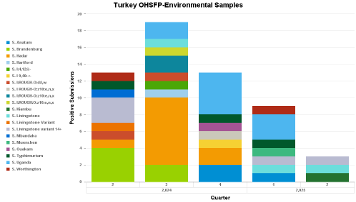
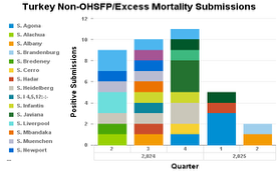
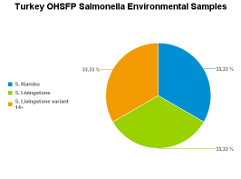
Provincial slaughter plants condemnations:
Turkey processed and condemnation percentage (March-May 2025) with an increase percentage of condemnation on the turkeys slaughtered in May.
| March | April | May | |
| Turkey slaughtered | 7,088 | 11,408 | 5,484 |
| Turkey condemned | 124 | 223 | 196 |
| Percentage | 1.75 | 1.95 | 3.57 |
Turkey condemnation conditions (March-May 2025). Top 3 main conditions listed for this quarter were: ascites, contamination and airsacculitis.
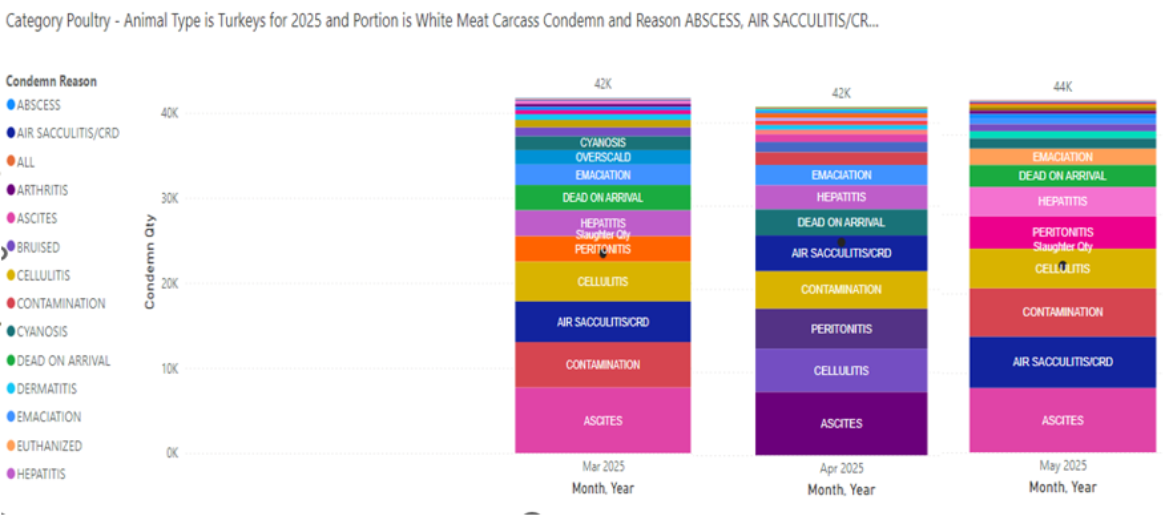
Number of turkeys slaughtered by region, Jan-Dec 2024 and Jan-Feb 2025. From CAHSS Federally Inspected Slaughter Data.
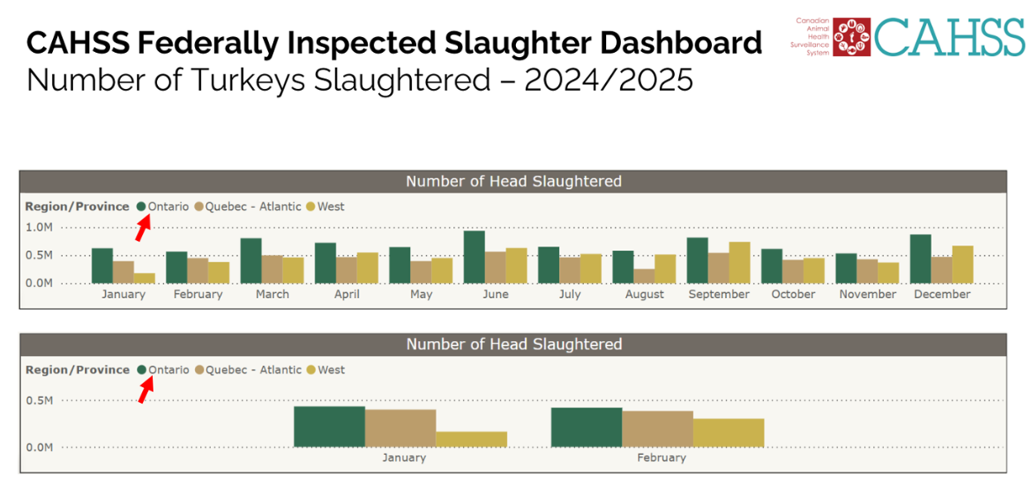
Top 10 turkey post-mortem condemnation conditions per 10,000 slaughtered, Jan-Dec 2024 (CAHSS Federally Inspected Slaughter Data).
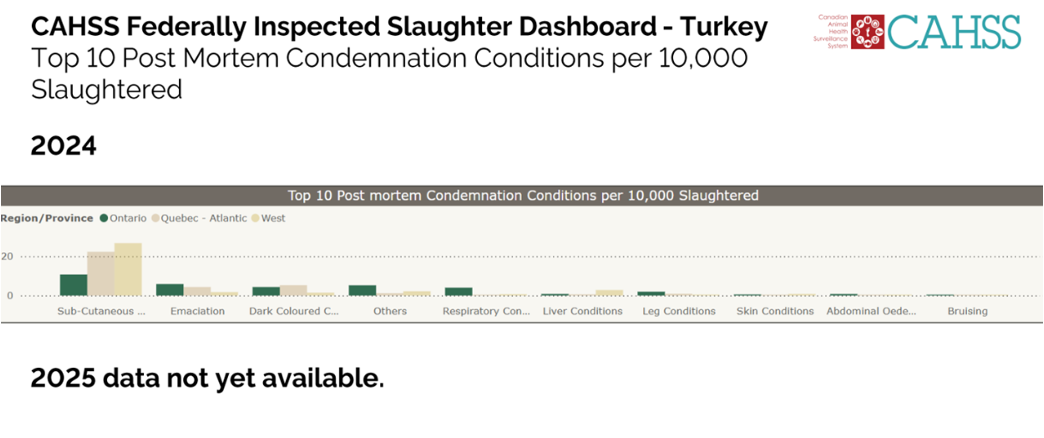 Subcutaneous conditions, emaciation, and “other” conditions were reported as the main conditions for condemnation for turkeys slaughtered in federally inspected plants in Ontario in 2024.
Subcutaneous conditions, emaciation, and “other” conditions were reported as the main conditions for condemnation for turkeys slaughtered in federally inspected plants in Ontario in 2024.
Small Flock
Chickens:
AHL: Diagnoses at AHL included intestinal parasitism (coccidiosis, nematodes, protozoa), Marek’s disease, neoplasia (adenocarcinoma, squamous cell carcinoma, lymphoid neoplasia), pododermatitis (Staphylococcus chromogenes), salpingitis, bacterial septicemia, pneumonia (Aspergillus fumigatus, E. coli), fatty liver hemorrhagic syndrome, IBV / M. gallisepticum / M. synoviae, cannibalism, IBV, heterophilic conjunctivitis / blepharitis, ingluvitis, gizzard/duodenum impaction and M. synoviae.
ILT: 1 case (unclassified, TCGG cluster).
Gamebird/Ratities:
AHL: Three quail cases submitted this quarter.
Quail:
1) Aspergillosis
2) Coccidiosis, heterophilic typhlitis with cecal cores.
3) Splenic rupture and hemorrhage.
Also, on virology a unique fowl adenovirus was detected.
Waterfowl:
AHL: Five duck cases submitted this quarter.
Ducks:
1) Muscovy – Increased liver iron.
2) Muscovy – Airsacculitis, tracheitis and pneumonia.
3) Pekin – Cholestasis, bild duct hyperplasia.
4) Pekin – Septicemia (E. coli, E. cecorum)
5) No diagnosis.
Pigeon:
AHL: One pigeon case submitted this quarter.
1) Pied pigeon – Crop stasis with yeast overgrowth.
Practitioners: Information provided with the clinical impression in chickens and waterfowl:
Frequency of conditions seen in the practice:
Common : ectoparasitism, Marek’s disease, other neoplasia (suspected renal/testicular neoplasia but not confirmed), soft tissue injury secondary to trauma and pododermatitis.
Rare : GI impaction, peritonitis/salpingitis and ascites.
Not seen : intestinal parasitism, vent trauma, bacterial septicemia, FLHS, toxins, pneumonia/airsacculitis, urate nephrosis/ visceral urates, articular urate deposits, ILT, histomoniasis, erysipelas, Mycoplasma and aMPV.
Changes since last quarter: stable conditions: trauma, ectoparasitism and other neoplasia; increased cases of Marek’s diseases, GI impaction, pododermatitis, peritonitis/salpingitis and ascites.
Poultry research from Ontario and beyond
Events and News
Poultry Industry Council events: https://www.poultryindustrycouncil.ca/events Poultry Health Research Network information, events, and lectures can be accessed on the PHRN website: https://phrn.net/ or on the PHRN YouTube channel: https://www.youtube.com/user/PoultryHRN
Thank You! We thank the following poultry veterinarians who completed the veterinary survey:
Dr. Tim Abolarin, Dr. Elizabeth Black, Dr. Joanne Dias, Dr. Daniella Di Pirro, Dr. Fernando Salgado-Bierman, Dr. Shahbaz Haq, Dr. Elana Huong, Dr. Anastasia Novy, Dr. Mike Petrik, Dr. Joanne Rafuse, Dr. Nahal Ramezani, Dr. Ben Schlegel, Dr. Chanelle Taylor, Dr. Brenna Tuer, Dr. Alex Weisz, and Dr. Jessalyn Walkey. Small Flock: Dr. Amari Patel.


